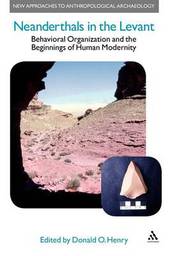
|
Neanderthals in the Levant: Behavioural Organization and the Beginnings of Human Modernity
Hardback
Main Details
| Title |
Neanderthals in the Levant: Behavioural Organization and the Beginnings of Human Modernity
|
| Authors and Contributors |
Edited by Professor Donald O. Henry
|
| Series | New Approaches to Anthropological Archaeology |
|---|
| Physical Properties |
| Format:Hardback | | Pages:338 | | Dimensions(mm): Height 297,Width 210 |
|
| Category/Genre | Prehistoric archaeology |
|---|
| ISBN/Barcode |
9780826458032
|
| Classifications | Dewey:569.9 |
|---|
| Audience | | Professional & Vocational | |
|---|
| Illustrations |
120 bw illus
|
|
Publishing Details |
| Publisher |
Bloomsbury Publishing PLC
|
| Imprint |
Leicester University Press
|
| Publication Date |
1 October 2003 |
| Publication Country |
United Kingdom
|
Description
The volume traces the controversy that revolves around the bio-cultural relationships of Archaic (Neanderthal) and Modern humans at global and regional, Levantine scales. The focus of the book is on understanding the degree to which the behavioral organization of Archaic groups differed from Moderns. To this end, a case study is presented for a 44-70,000 year old, Middle Paleolithic occupation of a Jordanian rockshelter. The research, centering on the spatial analysis of artifacts, hearths and related data, reveals how the Archaic occupants of the shelter structured their activities and placed certain conceptual labels on different parts of the site. The structure of Tor Faraj is compared to site structures defined for modern foragers, in both ethnographic and archaeological contexts, to measure any differences in behavioral organization. The comparisons show very similar structures for Tor Faraj and its modern cohorts. The implications of this finding challenge prevailing views in the emergence of modern human controversy in which Archaic groups are thought to have had inferior cognition and less complex behavioral-social organization than modern foragers. And, it is generally thought that such behaviors only emerged after the appearance of the Upper Paleolithic, dated some 10-20,000 years later than the occupation of Tor Faraj.
Author Biography
Donald O. Henry is Professor Emeritus of Anthropology at the University of Tulsa, USA. He is the author of several books and numerous articles covering his over 25 years of archaeological research on prehistoric human ecology in the Near East.
Reviews'This is the most significant report of a Middle Paleolithic site of this region to appear in many years and it raises the bar considerably in terms of the depth of analysis and quality of presentation. Not at all just a laundry list of material recovered from Jordanian site of Tor Faraj, it is instead a tightly integrated collection of studies, ranging from site formation to behavioral interpretation, that builds on the best of current archaeological method and theory in the context of modern human origins. While an invaluable resource for all Middle Paleolithic scholars, it also serves as a model for the entire archaeological community of what modern research design, excavation, analysis, and reporting can be.' Professor Harold L. Dibble, Professor in Anthropology, University of Pennsylvania Museum, USA 'D.O. Henry is undoubtedly one of the most prominent archaeologists currently working in the Near East. In his new book Henry not only reports on his excavations of a desert rockshelter in Jordan, but also skillfully places the scientific results in their proper evolutionary context. This volume is a major addition to the archaeological record of the Neanderthals of western Asia, as well as our knowledge of cave sites in arid areas, which have never been explored prior to Henry's project.' Professor Ofer Bar-Yosef, Peabody Museum, Harvard University, USA '...a major contribution to our understanding of 'the' transition in this critical crossroads region of the world....and excellent book.' -Journal of Anthropological Research 'This book presents a coherent and convincing case for the demonstration of modern human behavior in a Middle Paleolithic rockshelter. The volume is well-illustrated with black and white line art and photos, and the chapters are data-rich....I conclude by wholeheartedly endorsing this book for all graduate students and professional anthropologists interested in the archaeology of modern human origins.' -Geoarchaeology, March 2005 '...a welcome addition to the literature on Middle Paleolithic sites outside the traditional core area of prehistoric research...Scholars interested in Levantine prehistory certainly should consult this book not only for its results, but also as a guide for implementing new analytical and methodological procedures in middle Paleolithic research.' -PaleoAnthropology, June 2005 '[T]his is a well-written, well-presented publication of a highly significant research project. It should be obligatory reading to anyone involved in studies of the middle Paleolithic, the transition to the Upper Paleolithic, and the origins of "modern" human behavior.' Joao Zilhao, Journal of Field Archaeology, Vol. 31, 2006
|